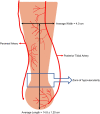Achilles Tendon Ruptures and Repair in Athletes-a Review of Sports-Related Achilles Injuries and Return to Play
- PMID: 35804260
- PMCID: PMC9463425
- DOI: 10.1007/s12178-022-09774-3
Achilles Tendon Ruptures and Repair in Athletes-a Review of Sports-Related Achilles Injuries and Return to Play
Abstract
Purpose of review: Achilles tendon ruptures (ATR) are detrimental to sports performance, and optimal treatment strategy and guidelines on return to play (RTP) remain controversial. This current review investigates the recent literature surrounding nonoperative versus operative management of ATR, clinical outcomes, and operative techniques to allow the athlete a successful return to their respective sport.
Recent findings: The Achilles tendon (AT) is crucial to the athlete, as it is essential for explosive activities such as running and jumping. Athletes that sustain an ATR play in fewer games and perform at a lower level of play compared to age-matched controls. Recent studies also theorize that ATRs occur due to elongation of the tendon with fatigue failure. Biomechanical studies have focused on comparing modes of fixation under dynamic loading to recreate this mechanism. ATRs can be career-ending injuries. Fortunately, the recent incorporation of early weight-bearing and functional rehabilitation programming for non-operative and operative patients alike proves to be beneficial. Especially for those treated nonoperatively, with the incorporation of functional rehabilitation, the risk of re-rupture among non-operative patients is beginning to approach the historical lower risk of re-rupture observed among patients treated operatively. Despite this progress in decreasing risk of re-rupture particularly among non-operative patients, operative managements are associated with unique benefits that may be of particular interest for athletes and active individuals. Recent studies demonstrate that operative intervention improves strength and functional outcomes with more efficacy compared to nonoperative management with rehabilitation. The current literature supports operative intervention in elite athletes to improve performance and shorten the duration to RTP. However, we acknowledge that surgical intervention does have inherent risks. Ultimately, most if not all young and/or high-level athletes with an ATR benefit from surgical repair, but it is crucial to take a stepwise algorithmic approach and consider other factors, which may lead towards nonoperative intervention. These factors include age, chronicity of injury, gap of ATR, social factors, and medical history amongst others in this review.
Keywords: Achilles tendon; Achilles tendon rupture; Athlete injury; Return to play.
© 2022. The Author(s), under exclusive licence to Springer Science+Business Media, LLC, part of Springer Nature.
Conflict of interest statement
The authors did not receive support from any organization for the submitted work. Dr. Michael Aynardi is a consultant for Arthrex Inc., Zimmer Biomet, and Stryker. The other authors have no relevant financial or non-financial interests to disclose.
Figures



References
-
- Westermann RW, Kerr ZY, Wehr P, Amendola A. Increasing lower extremity injury rates across the 2009-2010 to 2014-2015 seasons of National Collegiate Athletic Association Football: an unintended consequence of the “targeting” rule used to prevent concussions? Am J Sports Med. 2016;44(12):3230–3236. doi: 10.1177/0363546516659290. - DOI - PubMed
Publication types
LinkOut - more resources
Full Text Sources
Research Materials
Miscellaneous

